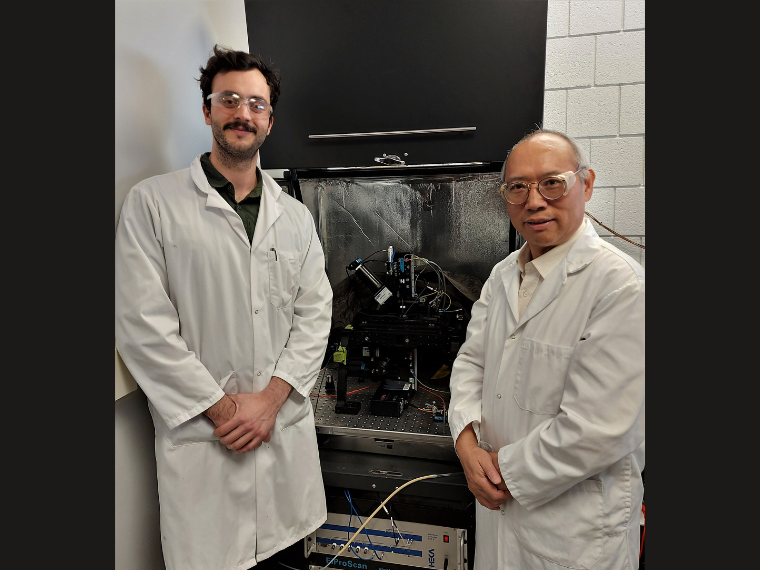Catalysts' Edge: Powering Hydrogen From Water

Exploiting catalysts' capabilities, Dr. Chen's team employs UV-Vis spectroscopy and SPECM to enhance water electrolysis efficiency for sustainable hydrogen fuel generation.
Water's Extraordinary Secret: Catalysts and Clean Energy
Did you know that water, the seemingly ordinary substance we encounter every day, holds a remarkable secret that could revolutionize clean energy generation? Unlocking this secret lies in the use of catalysts, incredible substances that enable the splitting of water into its elemental components: hydrogen and oxygen. This groundbreaking process, known as water electrolysis, offers a promising solution to our pressing energy and environmental challenges. Catalysts act as magical facilitators, speeding up the reaction without being consumed themselves. By harnessing their extraordinary powers, scientists are paving the way for a sustainable future powered by clean hydrogen fuel. The allure of this technology lies not only in its potential to combat climate change but also in its wide-ranging benefits that attract a variety of audiences, from environmentalists eager to reduce carbon emissions to investors seeking lucrative opportunities in the emerging green economy.
Overcoming Challenges: The Quest for High-Performance Catalysts
Despite the immense potential of water electrolysis as a clean energy solution, one critical challenge remains: the lack of efficient and high-performance catalysts. The development of catalysts that can effectively and economically drive the water-splitting reaction is a complex and ongoing pursuit. In this regard, understanding the importance of optical properties and electrochemical activities at a localized level is paramount. These properties govern the fundamental processes occurring at the catalyst's surface, influencing its ability to drive chemical reactions efficiently. Optical properties, such as light absorption, can be harnessed to enhance catalytic performance. Similarly, electrochemical activities, such as the ability to exchange electrons and ions with the surrounding environment, are crucial for driving redox reactions. Catalysts with high electrochemical activity can facilitate efficient charge transfer, minimizing energy losses during the reaction. By understanding and manipulating these properties at the localized level, researchers can design catalysts with tailored characteristics, enabling precise control over reaction pathways, selectivity on reaction products, and overall efficiency.
In the pursuit of developing high-performance catalysts for hydrogen production, a significant challenge lies in the absence of tools capable of simultaneously measuring both the optical properties and electrochemical activities of materials at a localized level. The ability to analyze and characterize the optical behavior and electrochemical performance of catalysts at a localized level is crucial for tailoring their properties and optimizing their efficiency. By bridging this gap and developing innovative techniques that can provide real-time, spatially-resolved information, researchers can gain invaluable insights into the underlying mechanisms governing catalytic processes.
Innovation Unleashed: Dual-Technique Approach
Dr. Aicheng Chen's research team at the University of Guelph has come up with an innovative approach that combines two advanced techniques. The first technique is called Ultraviolet-visible (UV-Vis) spectroscopy. It analyzes how a material absorbs light, providing valuable information about its optical and electronic properties. By using UV-Vis spectroscopy, researchers can understand the material's behaviour and characteristics related to light absorption. The second technique scanning photoelectrochemical microscopy (SPECM) allows them to study the local behaviour of photoelectrochemical activities. By using SPECM, they can monitor how efficiently the catalyst converts light into electrical energy at specific points on its surface. By integrating these two methods, the Chen team gains a deeper understanding of how different materials perform to facilitate the optimization of their design.
The outcome of this project offers a powerful tool for designing and developing new catalysts specifically for hydrogen production. By being able to study and understand the surface-level behaviour of catalysts, researchers can make more informed decisions and improvements to enhance their performance. Moreover, the Chen team aims to expand the application of this technique to investigate other electrocatalysts and photocatalysts. This opens up exciting possibilities for developing more efficient and sustainable catalysts for a wide range of applications beyond hydrogen production.
In reflecting on the research, Dr. Chen states, "With this new technique, we can correlate surface morphologies and optical properties with the photocatalytic activities, providing us with a new tool for the design and development of new catalysts. This underscores the significance of the research and the potential it holds for future advancements in green energy."
This story was written by Kasra Ghasemi as part of the Science Communicators: Research @ CEPS initiative. Kasra is a PhD candidate in the School ofEngineering under Dr. Syeda Humaira Tasnim and Shohel Mahmud. His research focus is on developing innovative solutions to poor packaging systems and conventional refrigeration methods and their contributions to food waste and global warming – a Latent Heat Thermal Energy Storage system with micro-scale capsules.
Funding Acknowledgement: This research is funded by two prestigious sources. The first one is the NSERC Discovery Grant, a financial aid designed to support innovative research in various fields of study. This grant plays a critical role in enabling researchers like Dr. Chen to push the boundaries of knowledge in their respective areas. The second source of funding is the Canada Foundation for Innovation (CFI) which has contributed by providing the facilities and equipment required to conduct the research.
Reference: E. Mena-Morcillo, J. van der Zalm, and A. Chen, “Spatially Resolved Optical Spectroscopic Measurements with Simultaneous Photoelectrochemical Mapping Using Scanning Electrochemical Probe Microscopy,” J. Phys. Chem. Lett., vol. 14, no. 19, pp. 4600–4606, May 2023, doi: 10.1021/acs.jpclett.3c00603.